2015 Peugeot 208 steering
[x] Cancel search: steeringPage 107 of 341
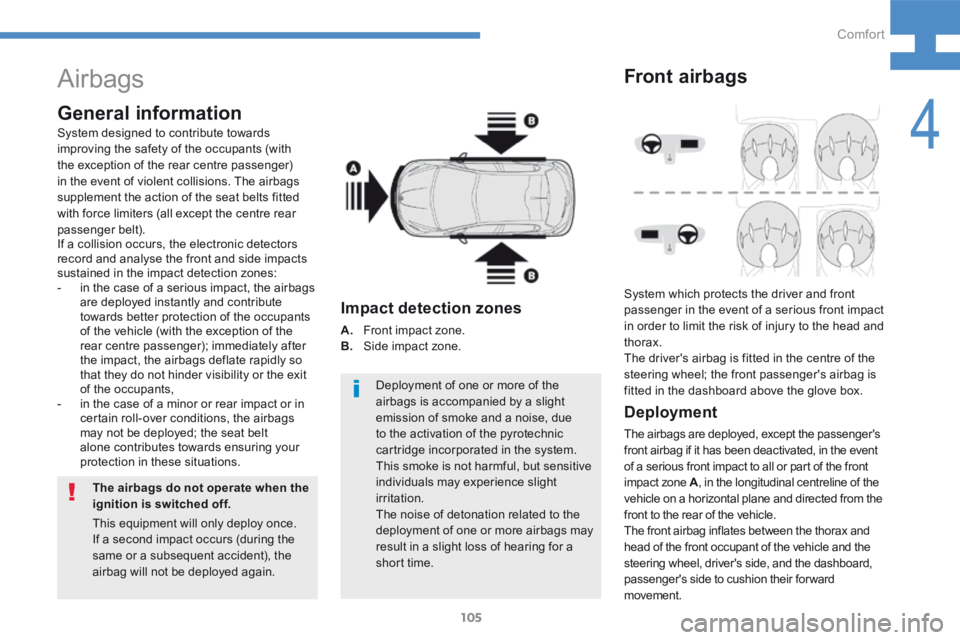
105
208_en_Chap04_confort_ed01-2015
Airbags
General information
The airbags do not operate when the
ignition is switched off.Deployment of one or more of the
airbags is accompanied by a slight
emission of smoke and a noise, due
to the activation of the pyrotechnic
cartridge incorporated in the system.
This smoke is not harmful, but sensitive
individuals may experience slight
irritation.
The noise of detonation related to the
deployment of one or more airbags may
result in a slight loss of hearing for a
short time.
Impact detection zones
A.
Front impact zone.
B. Side impact zone.
Front airbags
Deployment
The airbags are deployed, except the passenger's
front airbag if it has been deactivated, in the event
of a serious front impact to all or part of the front
impact zone A, in the longitudinal centreline of the
vehicle on a horizontal plane and directed from the
front to the rear of the vehicle.
The front airbag inflates between the thorax and
head of the front occupant of the vehicle and the
steering wheel, driver's side, and the dashboard,
passenger's side to cushion their forward
movement. System which protects the driver and front
passenger in the event of a serious front impact
in order to limit the risk of injury to the head and
thorax.
The driver's airbag is fitted in the centre of the
steering wheel; the front passenger's airbag is
fitted in the dashboard above the glove box.
This equipment will only deploy once.
If a second impact occurs (during the
same or a subsequent accident), the
airbag will not be deployed again.
System designed to contribute towards
improving the safety of the occupants (with
the exception of the rear centre passenger)
in the event of violent collisions. The airbags
supplement the action of the seat belts fitted
with force limiters (all except the centre rear
passenger belt).
If a collision occurs, the electronic detectors
record and analyse the front and side impacts
sustained in the impact detection zones:
-
in the case of a serious impact, the airbags
are deployed instantly and contribute
towards better protection of the occupants
of the vehicle (with the exception of the
rear centre passenger); immediately after
the impact, the airbags deflate rapidly so
that they do not hinder visibility or the exit
of the occupants,
- in the case of a minor or rear impact or in
certain roll-over conditions, the airbags
may not be deployed; the seat belt
alone contributes towards ensuring your
protection in these situations.
4
Comfort
Page 110 of 341
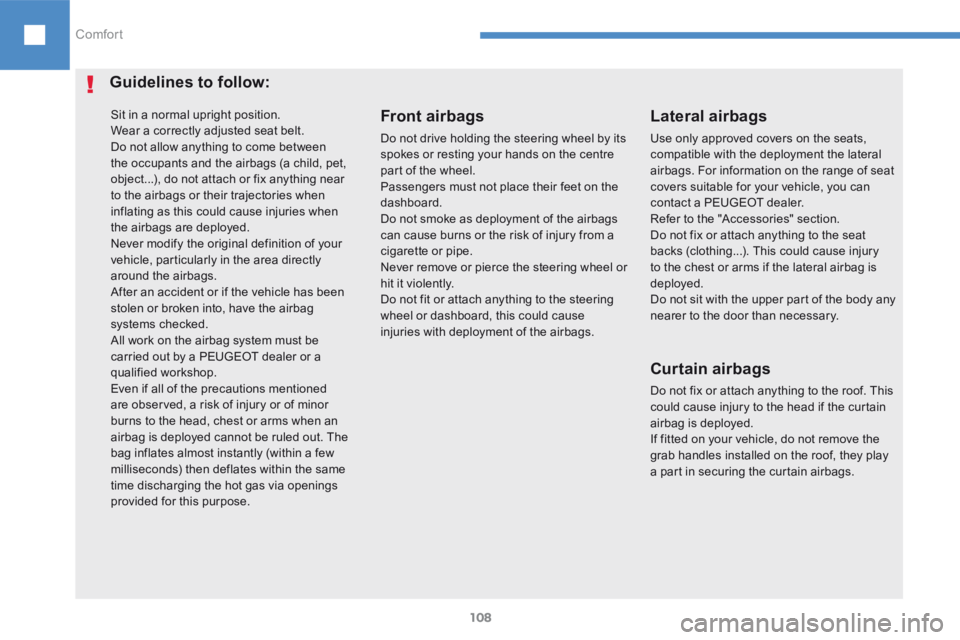
108
208_en_Chap04_confort_ed01-2015
Sit in a normal upright position.
Wear a correctly adjusted seat belt.
Do not allow anything to come between
the occupants and the airbags (a child, pet,
object...), do not attach or fix anything near
to the airbags or their trajectories when
inflating as this could cause injuries when
the airbags are deployed.
Never modify the original definition of your
vehicle, particularly in the area directly
around the airbags.
After an accident or if the vehicle has been
stolen or broken into, have the airbag
systems checked.
All work on the airbag system must be
carried out by a PEUGEOT dealer or a
qualified workshop.
Even if all of the precautions mentioned
are observed, a risk of injury or of minor
burns to the head, chest or arms when an
airbag is deployed cannot be ruled out. The
bag inflates almost instantly (within a few
milliseconds) then deflates within the same
time discharging the hot gas via openings
provided for this purpose.Lateral airbags
Use only approved covers on the seats,
compatible with the deployment the lateral
airbags. For information on the range of seat
covers suitable for your vehicle, you can
contact a PEUGEOT dealer.
Refer to the "Accessories" section.
Do not fix or attach anything to the seat
backs (clothing...). This could cause injury
to the chest or arms if the lateral airbag is
deployed.
Do not sit with the upper part of the body any
nearer to the door than necessary.
Front airbags
Do not drive holding the steering wheel by its
spokes or resting your hands on the centre
part of the wheel.
Passengers must not place their feet on the
dashboard.
Do not smoke as deployment of the airbags
can cause burns or the risk of injury from a
cigarette or pipe.
Never remove or pierce the steering wheel or
hit it violently.
Do not fit or attach anything to the steering
wheel or dashboard, this could cause
injuries with deployment of the airbags.
Guidelines to follow:Curtain airbags
Do not fix or attach anything to the roof. This
could cause injury to the head if the curtain
airbag is deployed.
If fitted on your vehicle, do not remove the
grab handles installed on the roof, they play
a part in securing the curtain airbags.
Comfort
Page 115 of 341
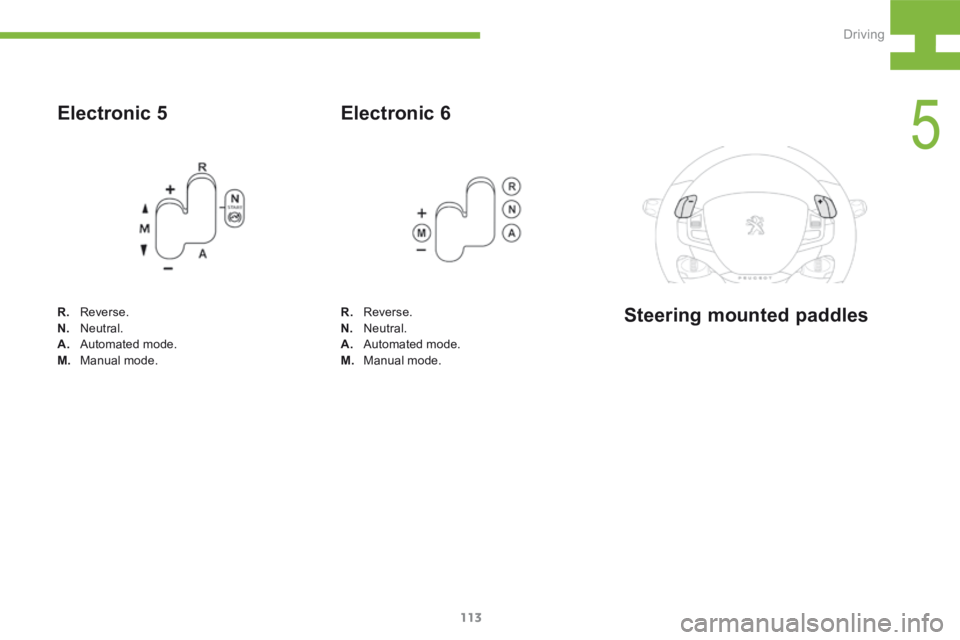
113
208_en_Chap05_conduite_ed01-2015
Electronic 5
R. Reverse.
N. Neutral.
A. Automated mode.
M. Manual mode.
Electronic 6
R. Reverse.
N. Neutral.
A. Automated mode.
M. Manual mode.Steering mounted paddles
5
Driving
Page 116 of 341
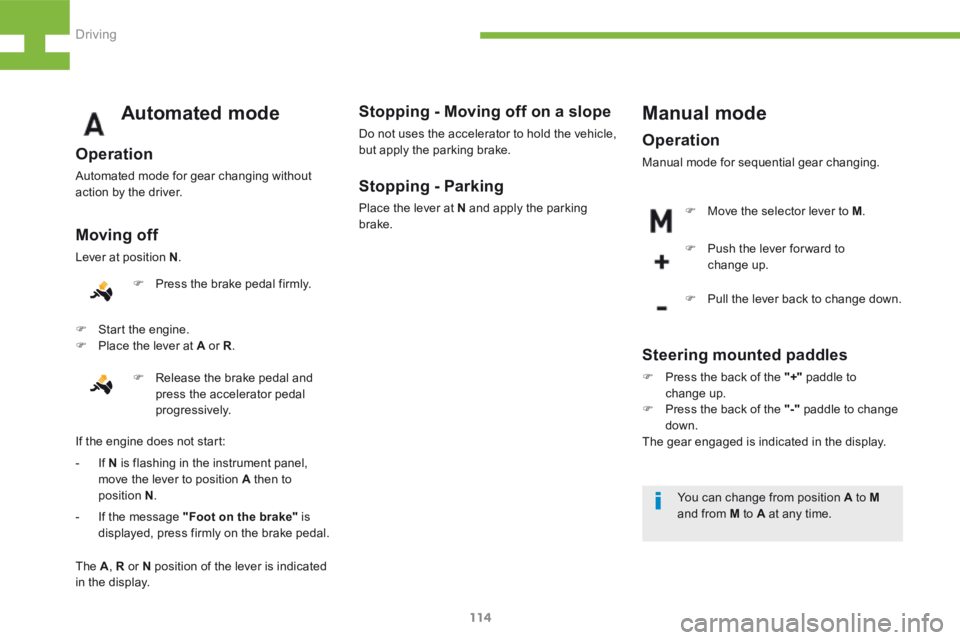
114
208_en_Chap05_conduite_ed01-2015
Stopping - Moving off on a slope
Do not uses the accelerator to hold the vehicle,
but apply the parking brake.You can change from position A to M
and from M to A at any time.
Stopping - Parking
Place the lever at N and apply the parking
brake.
Manual mode
Operation
Manual mode for sequential gear changing.F Push the lever for ward to
change up.
F Pull the lever back to change down.
F
Move the selector lever to M .
Automated mode
Operation
Automated mode for gear changing without
action by the driver.
Moving off
Lever at position N.
F Press the brake pedal firmly.
F Release the brake pedal and
press the accelerator pedal
progressively.
- If N is flashing in the instrument panel,
move the lever to position A then to
position N .
- If the message "Foot on the brake" is
displayed, press firmly on the brake pedal.
F
Start the engine.
F Place the lever at A or R .
The A , R or N position of the lever is indicated
in the display.
If the engine does not start:
Steering mounted paddles
F
Press the back of the "+" paddle to
change up.
F Press the back of the "-" paddle to change
down.
The gear engaged is indicated in the display.
Driving
Page 119 of 341
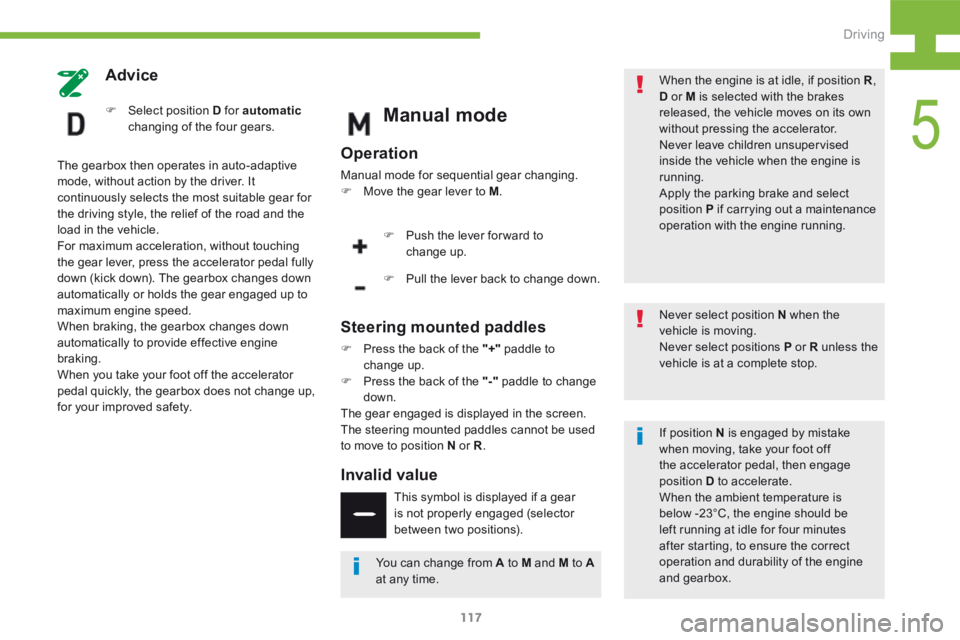
117
208_en_Chap05_conduite_ed01-2015
Advice
F Select position D for automatic
changing of the four gears.
The gearbox then operates in auto-adaptive
mode, without action by the driver. It
continuously selects the most suitable gear for
the driving style, the relief of the road and the
load in the vehicle.
For maximum acceleration, without touching
the gear lever, press the accelerator pedal fully
down (kick down). The gearbox changes down
automatically or holds the gear engaged up to
maximum engine speed.
When braking, the gearbox changes down
automatically to provide effective engine
braking.
When you take your foot off the accelerator
pedal quickly, the gearbox does not change up,
for your improved safety.Manual mode
Operation
Manual mode for sequential gear changing.
F Move the gear lever to M .
F Push the lever for ward to
change up.
F Pull the lever back to change down.
Steering mounted paddles
F Press the back of the "+" paddle to
change up.
F Press the back of the "-" paddle to change
down.
The gear engaged is displayed in the screen.
The steering mounted paddles cannot be used
to move to position N or R .
Invalid value
This symbol is displayed if a gear
is not properly engaged (selector
between two positions). When the engine is at idle, if position R
,
D or M is selected with the brakes
released, the vehicle moves on its own
without pressing the accelerator.
Never leave children unsupervised
inside the vehicle when the engine is
running.
Apply the parking brake and select
position P if carrying out a maintenance
operation with the engine running.
Never select position N when the
vehicle is moving.
Never select positions P or R unless the
vehicle is at a complete stop.
You can change from A to M and M to A
at any time. If position N is engaged by mistake
when moving, take your foot off
the accelerator pedal, then engage
position
D to accelerate.
When the ambient temperature is
below -23°C, the engine should be
left running at idle for four minutes
after starting, to ensure the correct
operation and durability of the engine
and gearbox.
5
Driving
Page 124 of 341
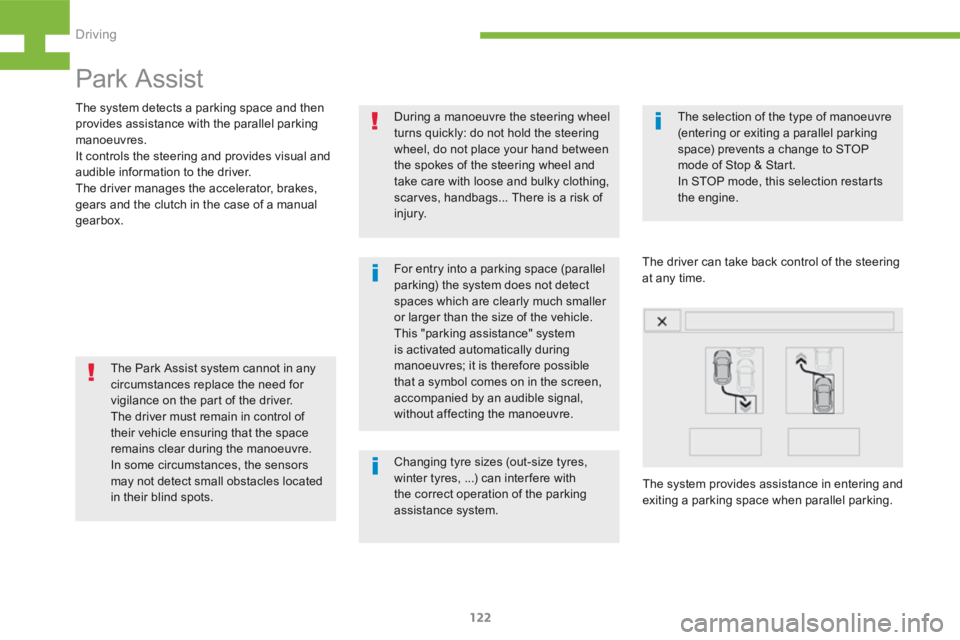
122
208_en_Chap05_conduite_ed01-2015
Park Assist
For entry into a parking space (parallel
parking) the system does not detect
spaces which are clearly much smaller
or larger than the size of the vehicle.
This "parking assistance" system
is activated automatically during
manoeuvres; it is therefore possible
that a symbol comes on in the screen,
accompanied by an audible signal,
without affecting the manoeuvre.The selection of the type of manoeuvre
(entering or exiting a parallel parking
space) prevents a change to STOP
mode of Stop & Start.
In STOP mode, this selection restarts
the engine.
The Park Assist system cannot in any
circumstances replace the need for
vigilance on the part of the driver.
The driver must remain in control of
their vehicle ensuring that the space
remains clear during the manoeuvre.
In some circumstances, the sensors
may not detect small obstacles located
in their blind spots. During a manoeuvre the steering wheel
turns quickly: do not hold the steering
wheel, do not place your hand between
the spokes of the steering wheel and
take care with loose and bulky clothing,
scarves, handbags... There is a risk of
injury.
The driver can take back control of the steering
at any time.
Changing tyre sizes (out-size tyres,
winter tyres, ...) can inter fere with
the correct operation of the parking
assistance system. The system provides assistance in entering and
exiting a parking space when parallel parking.
The system detects a parking space and then
provides assistance with the parallel parking
manoeuvres.
It controls the steering and provides visual and
audible information to the driver.
The driver manages the accelerator, brakes,
gears and the clutch in the case of a manual
gearbox.
Driving
Page 125 of 341
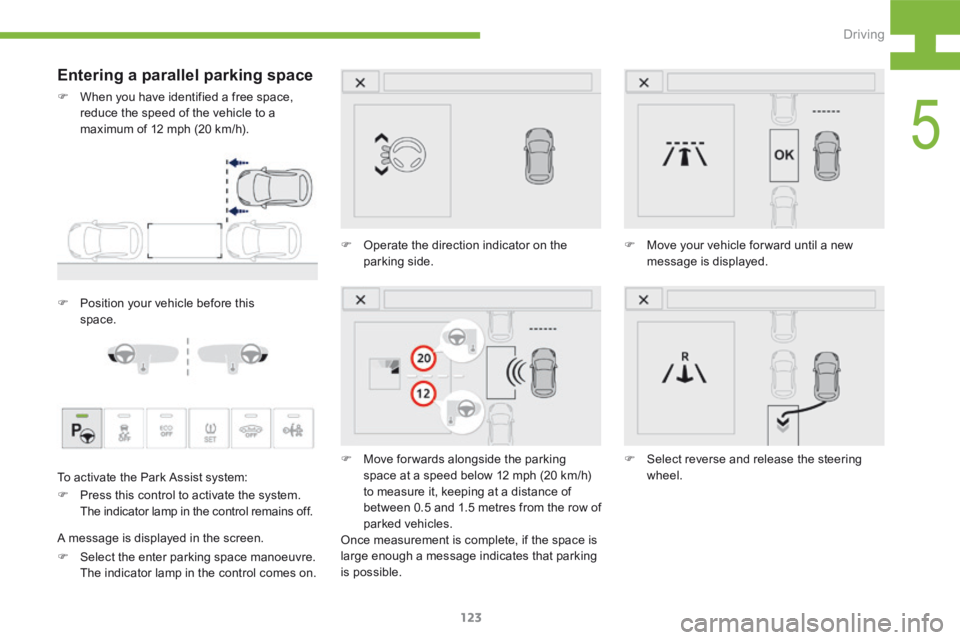
123
208_en_Chap05_conduite_ed01-2015
Entering a parallel parking space
F When you have identified a free space,
reduce the speed of the vehicle to a
maximum of 12 mph (20 km/h).
To activate the Park Assist system:
F Select the enter parking space manoeuvre.
The indicator lamp in the control comes on. F
Operate the direction indicator on the
parking side.
F Move for wards alongside the parking
space at a speed below 12 mph (20 km/h)
to measure it, keeping at a distance of
between 0.5 and 1.5 metres from the row of
parked vehicles.
Once measurement is complete, if the space is
large enough a message indicates that parking
is possible. F
Move your vehicle for ward until a new
message is displayed.
F Select reverse and release the steering
wheel.
A message is displayed in the screen. F Press this control to activate the system.
The indicator lamp in the control remains off.
F
Position your vehicle before this
space.
5
Driving
Page 126 of 341
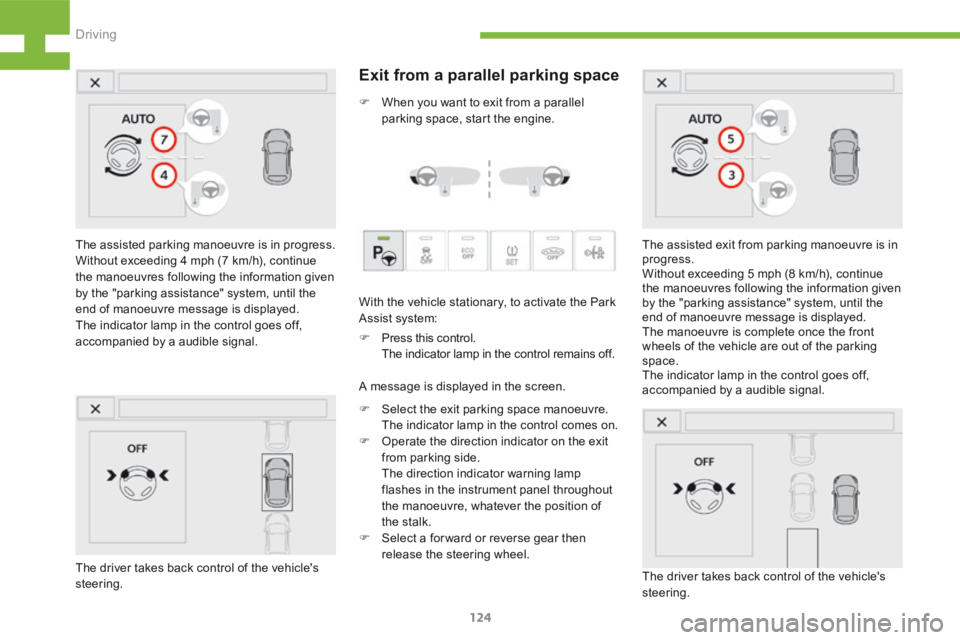
124
208_en_Chap05_conduite_ed01-2015
The assisted parking manoeuvre is in progress.
Without exceeding 4 mph (7 km/h), continue
the manoeuvres following the information given
by the "parking assistance" system, until the
end of manoeuvre message is displayed.
The indicator lamp in the control goes off,
accompanied by a audible signal.
Exit from a parallel parking space
F Select the exit parking space manoeuvre.
The indicator lamp in the control comes on.
F Operate the direction indicator on the exit
from parking side.
The direction indicator warning lamp
flashes in the instrument panel throughout
the manoeuvre, whatever the position of
the stalk.
F Select a for ward or reverse gear then
release the steering wheel.
F
Press this control.
The indicator lamp in the control remains off. The assisted exit from parking manoeuvre is in
progress.
Without exceeding 5 mph (8 km/h), continue
the manoeuvres following the information given
by the "parking assistance" system, until the
end of manoeuvre message is displayed.
The manoeuvre is complete once the front
wheels of the vehicle are out of the parking
space.
The indicator lamp in the control goes off,
accompanied by a audible signal.
The driver takes back control of the vehicle's
steering.
A message is displayed in the screen. With the vehicle stationary, to activate the Park
Assist system: F
When you want to exit from a parallel
parking space, start the engine.
The driver takes back control of the vehicle's
steering.
Driving